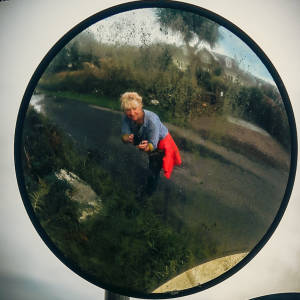The Old Butter House: one street #11
Another in the one street series and continuing with a milky theme started yesterday; I have finally walked down from the end of pier to where it meets the 'street'. The dinghies appear to be abandoned and the little slipway down to the seaweedy shore is treacherous - the main slipway can just be seen on the far right. The Christmas tree is still hanging on in there and the black rectangular blob is a pontoon.
It's the newly painted little white house that I like - it's the old Butter House. During the 18C and 19C Ireland was one of the main exporters of butter - mainly to northern Europe and the US. Everyone seemed to make their own and I assume bring it to the local butter house where there was a weekly market. I imagine butter was sold on the spot, but also collected together by merchants to make into a firkin (25kg/56lb) and it was then sent on to the wonderfully named Firkin Crane , the butter market in Cork, for regulation then export. Later butter making or churning was done at a local creamery.
This extract from the Schools Folklore Commission of 1938 explains how it was done - she's referring to a butter churn rather than a milk churn.
Churning
At present there are no churns at home as there was a creamery built adjacent to Durrus four or five years ago.; therefore the majority of the farmers of this locality take their milk there. The churn was of a circular shape resembling a barrel. This was placed on a stand regularly, on Thursday when the churning was performed. Once a week in summer and once a fortnight in winter.
When churning operations are being performed strangers who are passing by usually come in and help at the work or if this is not done it is considered very unlucky. There is a story told in this district about an old woman who is now dead. One day she was churning and a stranger came and went to the fire and put a coal on his pipe to light it. He then proceeded to go out again. The woman stopped him and told him to put the coal back in its place, as it was unlucky to take anything out of the house without helping with the churning.
It is by hand churning is done and it takes about an hour to do so. People who had but a few cows used a smaller churn than the one commonly used. When churning they used to beat the cream with a churn-dash which was worked upwards and downwards and from time to time it was given a rolling motion.
During the process water was poured in to wash the butter. This water was then released by removing a cork while the butter was fall out another way into a 'keeler'. The butter was then made into rolls and placed in a basket in which it was taken to market. Buttermilk was used for making cakes, and it was also regarded as a wholemeal drink.
Thanks for all the interesting comments and stories re yesterdays milk churns - it certainly brought back lots of memories.
And the sun's shining! Thank you admirer!

Comments
Sign in or get an account to comment.


